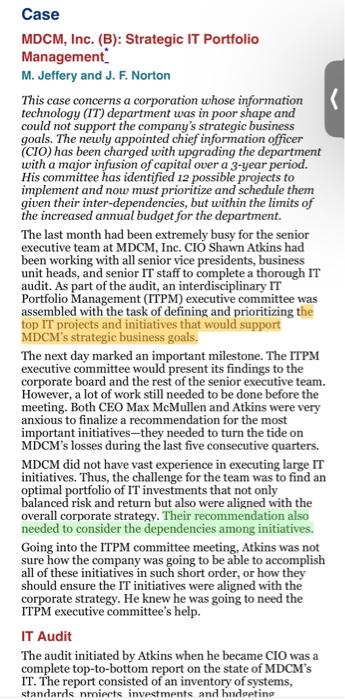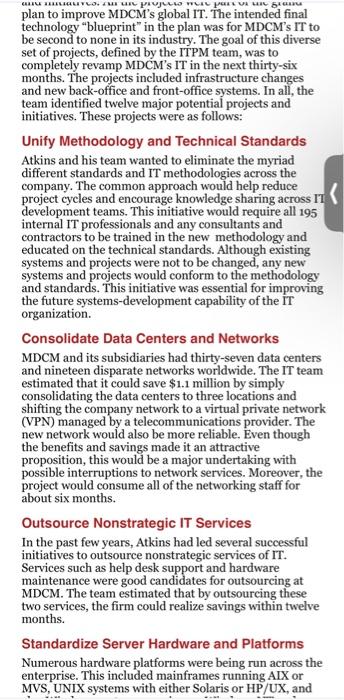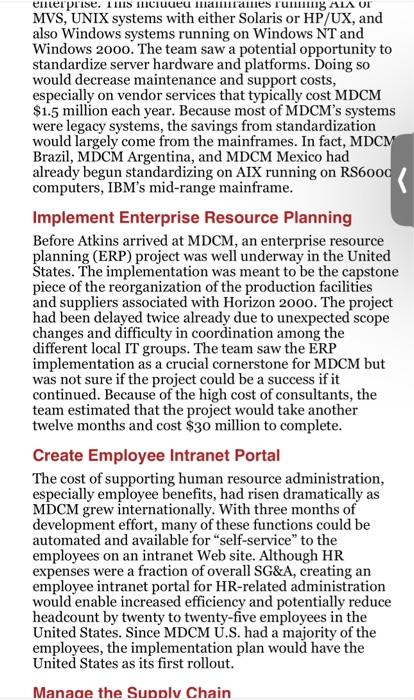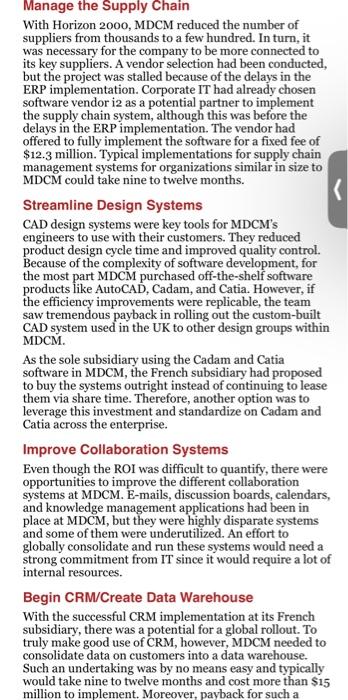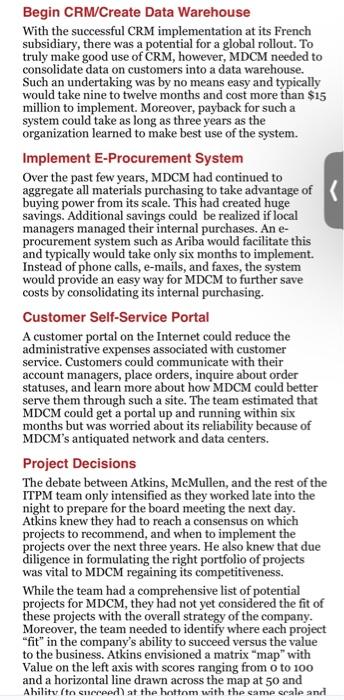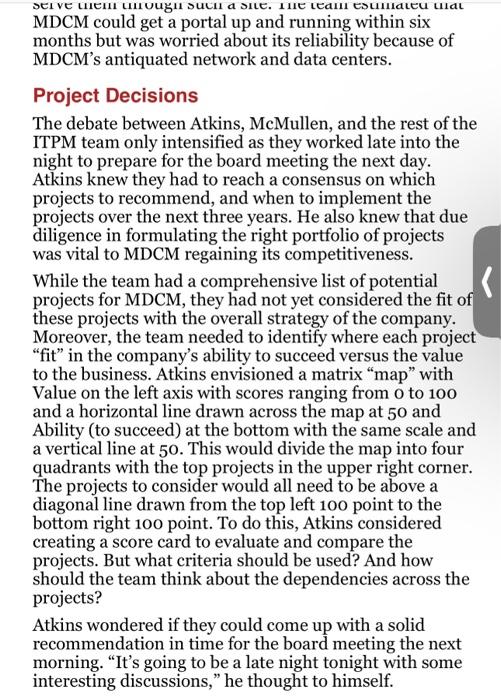A project Case

4. Given the above considerations, analyze the various project selection models described in the chapter and describe their relevance for this decision. Could the Real Options approach be of any value here? Could the Aggregate Project Plan be of value for MDCM? 5. What project selection model would you recommend? Why? How would you incorporate the Ability to Succeed-Value to the Business map into your analysis? 6. What projects should be initiated first, which later, and which, if any, eliminated? Show the 12 projects along a vertical "Projects" axis by rows in order of which projects depend on other prior projects, and the 36-month timeline on a bottom "Time" axis. Case MDCM, Inc. (B): Strategic IT Portfolio Management_ M. Jeffery and J. F. Norton This case concerns a corporation whose information technology (IT) department was in poor shape and could not support the company's strategic business goals. The newly appointed chief information officer (CIO) has been charged with upgrading the department with a major infusion of capital over a 3-year period. His committee has identified 12 possible projects to implement and now must prioritize and schedule them given their inter-dependencies, but within the limits of the increased annual budget for the department. The last month had been extremely busy for the senior executive team at MDCM, Inc. CIO Shawn Atkins had been working with all senior vice presidents, business unit heads, and senior IT staff to complete a thorough IT audit. As part of the audit, an interdisciplinary IT Portfolio Management (ITPM) executive committee was assembled with the task of defining and prioritizing the top IT proiects and initiatives that would support MDCM's strategic business goals. The next day marked an important milestone. The ITPM executive committee would present its findings to the corporate board and the rest of the senior executive team. However, a lot of work still needed to be done before the meeting. Both CEO Max McMullen and Atkins were very anxious to finalize a recommendation for the most important initiatives-they needed to turn the tide on MDCM's losses during the last five consecutive quarters. MDCM did not have vast experience in executing large IT initiatives. Thus, the challenge for the team was to find an optimal portfolio of IT investments that not only balanced risk and return but also were aligned with the overall corporate strategy. Their recommendation also needed to consider the dependencies among initiatives. Going into the ITPM committee meeting, Atkins was not sure how the company was going to be able to accomplish all of these initiatives in such short order, or how they should ensure the IT initiatives were aligned with the corporate strategy. He knew he was going to need the ITPM executive committee's help. IT Audit The audit initiated by Atkins when he became CIO was a complete top-to-bottom report on the state of MDCM's IT. The report consisted of an inventory of systems, standards nmiects invectments and hudceting The audit initiated by Atkins when he became CIO was a complete top-to-bottom report on the state of MDCM's IT. The report consisted of an inventory of systems, standards, projects, investments, and budgeting decisions made by all IT groups within MDCM in the past five years. The audit found exactly what Atkins and most people at the company already knew-MDCM's IT services had been badly mismanaged. The situation could only be described as disastrous in terms of IT's readiness to meet the challenges faced by the company, Years of poor investment decisions and managerial neglect left the IT department in such disarray that it resembled more a collection of systems pieced together than a single coordinated unit that could deliver the global IT capabilities necessary for MDCM. To his surprise, Atkins did have some positive findings. For example, MDCM France, the company's subsidiary in France, had successfully implemented a customer relationship management (CRM) system that had great potential if it were rolled out globally. Another example was a computer-assisted design (CAD) system developed by a group of design engineers in the UK that helped reduced the UK division's product development cycle time by 40 percent. These findings were comforting to Atkins because it seemed that MDCM had people who were capable of managing and building enterprise technologies that could be of great business benefit. The total MDCM IT budget in 2001 was $56.5 million, and Atkins found the IT headcount across the company to be 195 professionals worldwide. Corporate headquarters in the United States had the most staff at twenty-five, while the UK and France were second and third with staffs of fifteen and ten, respectively. The remainder were almost evenly scattered across the rest of the company locations. Top Projects and Initiatives After the IT audit, McMullen asked Atkins to estimate the cost of overhauling MDCM's IT. Atkins estimated the IT budget should be increased to $175 million per year for the next three years. However, before committing to a total cost, Atkins knew he had to figure out the portfolio of initiatives that should be implemented. Working with his top lieutenants, he put together an interdisciplinary team to create a short list of the most important projects and initiatives. All the projects were part of the grand plan to improve MDCM's global IT. The intended final technology "blueprint" in the plan was for MDCM's IT to be second to none in its industry. The goal of this diverse set of projects, defined by the ITPM team, was to plan to improve MDCM's global IT. The intended final technology "blueprint" in the plan was for MDCM's IT to be second to none in its industry. The goal of this diverse set of projects, defined by the ITPM team, was to completely revamp MDCM's IT in the next thirty-six months. The projects included infrastructure changes and new back-office and front-office systems. In all, the team identified twelve major potential projects and initiatives. These projects were as follows: Unify Methodology and Technical Standards Atkins and his team wanted to eliminate the myriad different standards and IT methodologies across the company. The common approach would help reduce project cycles and encourage knowledge sharing across IT development teams. This initiative would require all 195 internal IT professionals and any consultants and contractors to be trained in the new methodology and educated on the technical standards. Although existing systems and projects were not to be changed, any new systems and projects would conform to the methodology and standards. This initiative was essential for improving the future systems-development capability of the IT organization. Consolidate Data Centers and Networks MDCM and its subsidiaries had thirty-seven data centers and nineteen disparate networks worldwide. The IT team estimated that it could save $1.1 million by simply consolidating the data centers to three locations and shifting the company network to a virtual private network (VPN) managed by a telecommunications provider. The new network would also be more reliable. Even though the benefits and savings made it an attractive proposition, this would be a major undertaking with possible interruptions to network services. Moreover, the project would consume all of the networking staff for about six months. Outsource Nonstrategic IT Services In the past few years, Atkins had led several successful initiatives to outsource nonstrategic services of IT. Services such as help desk support and hardware maintenance were good candidates for outsourcing at MDCM. The team estimated that by outsourcing these two services, the firm could realize savings within twelve months. Standardize Server Hardware and Platforms Numerous hardware platforms were being run across the enterprise. This included mainframes running AIX or MVS, UNIX systems with either Solaris or HP/UX, and MVS, UNIX systems with either Solaris or HP/UX, and also Windows systems running on Windows NT and Windows 20oo. The team saw a potential opportunity to standardize server hardware and platforms. Doing so would decrease maintenance and support costs, especially on vendor services that typically cost MDCM $1.5 million each year. Because most of MDCM's systems were legacy systems, the savings from standardization would largely come from the mainframes. In fact, MDCM Brazil, MDCM Argentina, and MDCM Mexico had already begun standardizing on AIX running on RS60oo computers, IBM's mid-range mainframe. Implement Enterprise Resource Planning Before Atkins arrived at MDCM, an enterprise resource planning (ERP) project was well underway in the United States. The implementation was meant to be the capstone piece of the reorganization of the production facilities and suppliers associated with Horizon 200o. The project had been delayed twice already due to unexpected scope changes and difficulty in coordination among the different local IT groups. The team saw the ERP implementation as a crucial cornerstone for MDCM but was not sure if the project could be a success if it continued. Because of the high cost of consultants, the team estimated that the project would take another twelve months and cost $30 million to complete. Create Employee Intranet Portal The cost of supporting human resource administration, especially employee benefits, had risen dramatically as MDCM grew internationally. With three months of development effort, many of these functions could be automated and available for "self-service" to the employees on an intranet Web site. Although HR expenses were a fraction of overall SG\&A, creating an employee intranet portal for HR-related administration would enable increased efficiency and potentially reduce headcount by twenty to twenty-five employees in the United States. Since MDCM U.S. had a majority of the employees, the implementation plan would have the United States as its first rollout. Manage the Suoblv Chain Manage the Supply Chain With Horizon 2000, MDCM reduced the number of suppliers from thousands to a few hundred. In turn, it was necessary for the company to be more connected to its key suppliers. A vendor selection had been conducted, but the project was stalled because of the delays in the ERP implementation. Corporate IT had already chosen software vendor i2 as a potential partner to implement the supply chain system, although this was before the delays in the ERP implementation. The vendor had offered to fully implement the software for a fixed fee of $12.3 million. Typical implementations for supply chain management systems for organizations similar in size to MDCM could take nine to twelve months. Streamline Design Systems CAD design systems were key tools for MDCM's engineers to use with their customers. They reduced product design cycle time and improved quality control. Because of the complexity of software development, for the most part MDCM purchased off-the-shelf software products like AutoCAD, Cadam, and Catia. However, if the efficiency improvements were replicable, the team saw tremendous payback in rolling out the custom-built CAD system used in the UK to other design groups within MDCM. As the sole subsidiary using the Cadam and Catia software in MDCM, the French subsidiary had proposed to buy the systems outright instead of continuing to lease them via share time. Therefore, another option was to leverage this investment and standardize on Cadam and Catia across the enterprise. Improve Collaboration Systems Even though the ROI was difficult to quantify, there were opportunities to improve the different collaboration systems at MDCM. E-mails, discussion boards, calendars, and knowledge management applications had been in place at MDCM, but they were highly disparate systems and some of them were underutilized. An effort to globally consolidate and run these systems would need a strong commitment from IT since it would require a lot of internal resources. Begin CRM/Create Data Warehouse With the successful CRM implementation at its French subsidiary, there was a potential for a global rollout. To truly make good use of CRM, however, MDCM needed to consolidate data on customers into a data warehouse. Such an undertaking was by no means easy and typically would take nine to twelve months and cost more than $15 million to implement. Moreover, payback for such a Begin CRM/Create Data Warehouse With the successful CRM implementation at its French subsidiary, there was a potential for a global rollout. To truly make good use of CRM, however, MDCM needed to consolidate data on customers into a data warehouse. Such an undertaking was by no means easy and typically would take nine to twelve months and cost more than $15 million to implement. Moreover, payback for such a system could take as long as three years as the organization learned to make best use of the system. Implement E-Procurement System Over the past few years, MDCM had continued to aggregate all materials purchasing to take advantage of buying power from its scale. This had created huge savings. Additional savings could be realized if local managers managed their internal purchases. An eprocurement system such as Ariba would facilitate this and typically would take only six months to implement. Instead of phone calls, e-mails, and faxes, the system would provide an easy way for MDCM to further save costs by consolidating its internal purchasing. Customer Self-Service Portal A customer portal on the Internet could reduce the administrative expenses associated with customer service. Customers could communicate with their account managers, place orders, inquire about order statuses, and learn more about how MDCM could better serve them through such a site. The team estimated that MDCM could get a portal up and running within six months but was worried about its reliability because of MDCM's antiquated network and data centers. Project Decisions The debate between Atkins, McMullen, and the rest of the ITPM team only intensified as they worked late into the night to prepare for the board meeting the next day. Atkins knew they had to reach a consensus on which projects to recommend, and when to implement the projects over the next three years. He also knew that due diligence in formulating the right portfolio of projects was vital to MDCM regaining its competitiveness. While the team had a comprehensive list of potential projects for MDCM, they had not yet considered the fit of these projects with the overall strategy of the company. Moreover, the team needed to identify where each project "fit" in the company's ability to succeed versus the value to the business. Atkins envisioned a matrix "map" with Value on the left axis with scores ranging from o to 100 and a horizontal line drawn across the map at 50 and Ahilitu (to enceeped) at the hnttom with the eame seale and MDCM could get a portal up and running within six months but was worried about its reliability because of MDCM's antiquated network and data centers. Project Decisions The debate between Atkins, McMullen, and the rest of the ITPM team only intensified as they worked late into the night to prepare for the board meeting the next day. Atkins knew they had to reach a consensus on which projects to recommend, and when to implement the projects over the next three years. He also knew that due diligence in formulating the right portfolio of projects was vital to MDCM regaining its competitiveness. While the team had a comprehensive list of potential projects for MDCM, they had not yet considered the fit of these projects with the overall strategy of the company. Moreover, the team needed to identify where each project "fit" in the company's ability to succeed versus the value to the business. Atkins envisioned a matrix "map" with Value on the left axis with scores ranging from 0 to 100 and a horizontal line drawn across the map at 50 and Ability (to succeed) at the bottom with the same scale and a vertical line at 50 . This would divide the map into four quadrants with the top projects in the upper right corner. The projects to consider would all need to be above a diagonal line drawn from the top left 100 point to the bottom right 100 point. To do this, Atkins considered creating a score card to evaluate and compare the projects. But what criteria should be used? And how should the team think about the dependencies across the projects? Atkins wondered if they could come up with a solid recommendation in time for the board meeting the next morning. "It's going to be a late night tonight with some interesting discussions," he thought to himself


